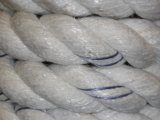Lockman® 3-Strand Twisted
 Designed for lighter locking, Lockman® is manufactured with a spun and filament blend polyester cover over a strand core of monofilament polypropylene. The lay of the rope is medium-soft to optimize tensile strength. The fuzzy softness of polyester cover yarns serves to diffuse heat buildup and offers excellent abrasion resistance. Lockman® is available with a high-tenacity co-polymer core upon request.
Designed for lighter locking, Lockman® is manufactured with a spun and filament blend polyester cover over a strand core of monofilament polypropylene. The lay of the rope is medium-soft to optimize tensile strength. The fuzzy softness of polyester cover yarns serves to diffuse heat buildup and offers excellent abrasion resistance. Lockman® is available with a high-tenacity co-polymer core upon request.
FEATURES & BENEFITS
- Excellent Abrasion Resistance
- Low Elongation
- Excellent Resistance to Heat Build Up
- Superior Wear to Traditional Combination Lines
- Good Handling Characteristics
| Dia. Inch | Size mm | Circ. | Linear Density | Weight 600' | Average Tenacity Lbs. | Average Tenacity Kgs. | Reel | Coil |
|---|---|---|---|---|---|---|---|---|
| 1-1/2" | 36 | 4-1/2" | 44.6 | 267.3 | 37,980 | 17,227 | R8902 | E0749 |
| 1-5/8" | 40 | 5" | 54.6 | 327.8 | 44,640 | 20,248 | R3041 | E1363 |
| 1-3/4" | 44 | 5-1/2" | 60.4 | 362.5 | 50,572 | 22,939 | R3039 | E0568 |
| 2" | 48 | 6" | 77.9 | 467.4 | 61,180 | 27,751 | R3040 | E0991 |
| 2-1/2" | 60 | 7-1/2" | 106.4 | 638.4 | 92,120 | 41,785 | R8930 | E1029 |
| 2-5/8" | 64 | 8" | 115.9 | 695.4 | 101,990 | 46,262 | R8931 | E1585 |
Lubelock® 3-Strand Twisted
 Designed for medium and heavy locking, Lubelock® has a cover of 100% fuzzy DuPont® T-77 multiplex Dacron® fiber. The core of each strand is 100% high strength SuperPro® co-polymer with a proprietary lubricant added to improve rendering. As tension is put on the rope, the lubrication migrates to the strand surface, decreasing fiber on fiber friction resulting in less heat build up.
Designed for medium and heavy locking, Lubelock® has a cover of 100% fuzzy DuPont® T-77 multiplex Dacron® fiber. The core of each strand is 100% high strength SuperPro® co-polymer with a proprietary lubricant added to improve rendering. As tension is put on the rope, the lubrication migrates to the strand surface, decreasing fiber on fiber friction resulting in less heat build up.
The co-polymer core and beefy multiplex polyester cover give Lubelock® superior tenacity. This enables the rope to be built with a firm lay to further improve abrasion resistance. Lubelock® is engineered to have all the right stuff: balance, tenacity, long working life, and ease of use.
FEATURES & BENEFITS
- Excellent Abrasion Resistance
- Low Elongation
- Excellent Resistance to Heat Build Up
- Superior Wear to Traditional Combination Lines
- Good Handling Characteristics
| Dia. Inch | Size mm | Circ. | Linear Density | Weight 600' | Average Tenacity Lbs. | Average Tenacity Kgs. | Reel | Coil |
|---|---|---|---|---|---|---|---|---|
| 1-1/2" | 36 | 4-1/2" | 46.9 | 281.4 | 43,200 | 19,142 | R8932 | E1586 |
| 1-5/8" | 40 | 5" | 57.5 | 345.0 | 49,600 | 22,498 | R8933 | E1587 |
| 1-3/4" | 44 | 5-1/2" | 63.6 | 381.6 | 53,800 | 24,403 | R8934 | E1588 |
| 2" | 48 | 6" | 82.0 | 492.0 | 66,500 | 30,164 | R8935 | E1362 |
| 2-1/2" | 60 | 7-1/2" | 112.0 | 672.0 | 98,000 | 44,452 | R8936 | E1589 |
| 2-5/8" | 64 | 8" | 122.0 | 732.0 | 108,500 | 49,215 | R8937 | E1590 |